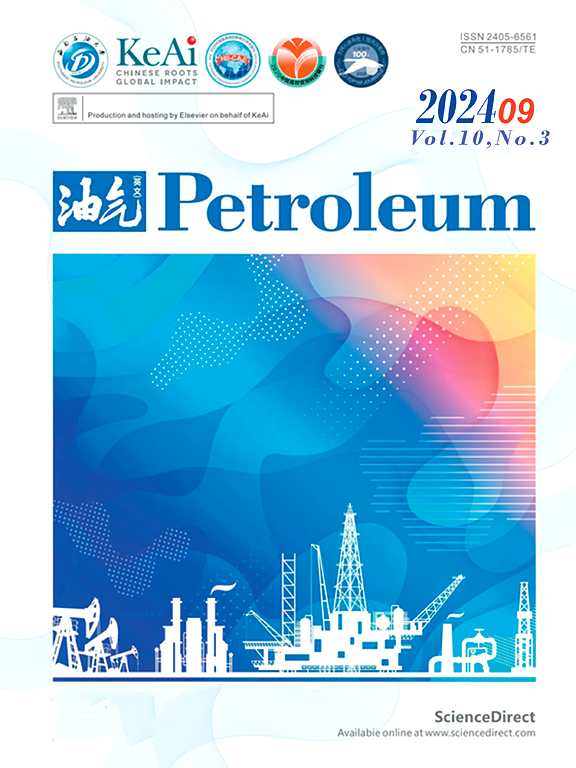Integrated reservoir characterization of the Permo-Triassic gas reservoirs in the Central Persian Gulf
IF 4.2
Q2 ENERGY & FUELS
引用次数: 0
Abstract
The upper Dalan and Kangan or Permian-Triassic carbonate formations in the central the Persian Gulf are considered as world's giant gas reservoirs. The primary purpose of this research is to model and evaluate the relationship between hydraulic flow units (HFUs), electrofacies and microfacies with systems tracts of Permian-Triassic sequences. By integrating the results of core data, petrographic studies, and petrophysical logs of the studied formations, hydraulic flow units and electrofacies were identified. Based on the results of petrographic studies, twelve microfacies were identified in terms of textural and depositional characteristics. Based on depositional setting, sedimentary facies and INPEFA values obtained from gamma ray log and gamma deviation log (GDL) in the context of sequence stratigraphy, zonation of Dalan and Kangan reservoirs is carried out. The zonation boundaries correspond to the key stratal surfaces (sequence boundary and maximum flooding surface). Seven petrographic rock types (PRT) were identified for the upper Dalan-Kangan reservoirs based on sedimentary texture, diagenetic process and dominant pores. Using porosity and permeability data from the core analysis, five hydraulic flow units were identified based on the flow zone indicator (FZI) method. Using multi-resolution graph-based clustering (MRGC) four electrofacies were detected from petrophysical data (gamma, neutron, density and acoustic logs). Subsequently, the INPEFA, GDL and electrofacies were spatially modeled using the sequential indicator simulation (SIS) and sequential Gaussian simulation (SGS) geostatistical methods. Finally, a clear agreement was revealed between the reservoir zones and the stratigraphic sequence framework. It this regard, the microfacies belonging to the high-energy and grain-dominated settings (packstone, grainstone) of leeward shoal, shoal and seaward shoal belts have the best reservoir units due to the influence of dissolution and dolomitization. The best reservoir units in the Permian-Triassic deposits in the middle of the upper Dalan and lower Kangan are developed in UDS4, upper KS2 and middle KS1 units. On the other hand, mud-dominated facies (mudstone, wackestone) and anhydrite textures are mostly associated with the low-energy lagoonal environments, between tidal flat and Sabkha. Non-reservoir units have been formed in the upper Dalan/Kangan and in the transgressive systems tract of UDS3-a, KS2-a and the lower and upper part of KS1 transgressive-highstand systems tract.
波斯湾中部二叠三叠纪天然气储层的综合储层特征描述
波斯湾中部的上大兰和坎干或二叠系-三叠系碳酸盐岩地层被认为是世界上最大的天然气储层。本研究的主要目的是模拟和评价二叠-三叠纪层序体系域与水力流动单元、电相和微相之间的关系。通过综合岩心数据、岩石学研究和所研究地层的岩石物理测井结果,确定了水力流动单元和电相。根据岩石学研究结果,根据构造和沉积特征,确定了12个微相。根据层序地层学背景、沉积相以及伽马测井和伽马偏差测井(GDL)的INPEFA值,对大兰、康干储层进行了分带。分带边界对应关键层面(层序边界和最大淹水面)。根据沉积结构、成岩作用和优势孔隙特征,确定了大兰-康干上段储层的7种岩相岩石类型。利用岩心分析的孔隙度和渗透率数据,基于流动区指示(FZI)方法确定了5个水力流动单元。利用多分辨率图聚类技术(MRGC),从岩石物理数据(伽马、中子、密度和声波测井)中检测出四种电相。随后,利用序贯指示模拟(SIS)和序贯高斯模拟(SGS)地统计学方法对INPEFA、GDL和电相进行了空间建模。最后,发现储层带与层序格架具有明显的一致性。因此,受溶蚀和白云化作用的影响,背风滩带、浅滩带和向海滩带的高能、颗粒为主(包岩、颗粒岩)微相具有最好的储集单元。二叠系—三叠系上大兰中段和下甘干段的储层单元发育在UDS4、KS2上段和KS1中段。另一方面,泥岩、泥岩和硬石膏结构主要与低能泻湖环境有关,介于潮滩和Sabkha之间。在大兰/坎干上段、UDS3-a、KS2-a海侵体系域和KS1海侵—高位体系域上下段均形成了非储层单元。
本文章由计算机程序翻译,如有差异,请以英文原文为准。
求助全文
约1分钟内获得全文
求助全文
来源期刊

Petroleum
Earth and Planetary Sciences-Geology
CiteScore
9.20
自引率
0.00%
发文量
76
审稿时长
124 days
期刊介绍:
Examples of appropriate topical areas that will be considered include the following: 1.comprehensive research on oil and gas reservoir (reservoir geology): -geological basis of oil and gas reservoirs -reservoir geochemistry -reservoir formation mechanism -reservoir identification methods and techniques 2.kinetics of oil and gas basins and analyses of potential oil and gas resources: -fine description factors of hydrocarbon accumulation -mechanism analysis on recovery and dynamic accumulation process -relationship between accumulation factors and the accumulation process -analysis of oil and gas potential resource 3.theories and methods for complex reservoir geophysical prospecting: -geophysical basis of deep geologic structures and background of hydrocarbon occurrence -geophysical prediction of deep and complex reservoirs -physical test analyses and numerical simulations of reservoir rocks -anisotropic medium seismic imaging theory and new technology for multiwave seismic exploration -o theories and methods for reservoir fluid geophysical identification and prediction 4.theories, methods, technology, and design for complex reservoir development: -reservoir percolation theory and application technology -field development theories and methods -theory and technology for enhancing recovery efficiency 5.working liquid for oil and gas wells and reservoir protection technology: -working chemicals and mechanics for oil and gas wells -reservoir protection technology 6.new techniques and technologies for oil and gas drilling and production: -under-balanced drilling/gas drilling -special-track well drilling -cementing and completion of oil and gas wells -engineering safety applications for oil and gas wells -new technology of fracture acidizing
 求助内容:
求助内容: 应助结果提醒方式:
应助结果提醒方式:


